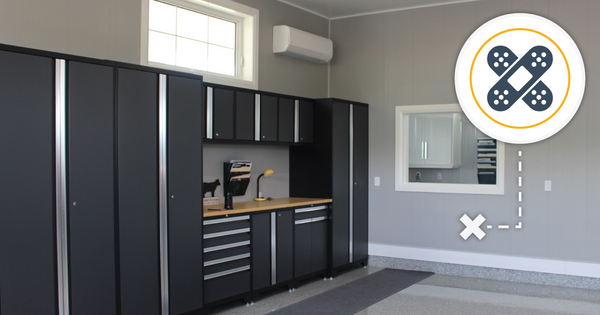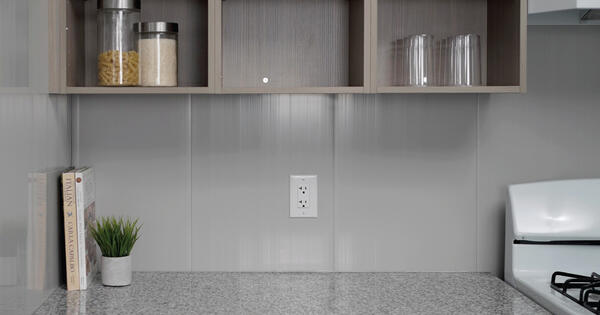When you're dealing with high moisture environments, three-way corners, window framing, or transitioning between Trusscore Wall&CeilingBoard and Trusscore SlatWall, you may run into some hiccups when installing your trims since these scenarios call for special considerations. In this blog post, we provide practical advice in the form of “dos and don’ts” to ensure a successful and seamless installation process.
A Brief Trusscore Trim Overview
Before we dive in, it’s helpful to get familiar with Trusscore trims. Trusscore offers a variety of PVC-based trims in both white and gray to help you put the perfect finishing touch on your project. Here are eight trims we see used for residential spaces:
The Dos and Don'ts of Installing Trusscore Trims in Specific Scenarios
When it comes to installing Trusscore trims, there are certain situations that may pose unique challenges. These four scenarios are ones we see pop up from time to time during residential installations. If you find yourself in any of these situations, here’s what to do.
Scenario 1: Addressing Three-Way Corners
During your installation, you’ll likely run into a corner with a three-way intersection, like when the inside corner of a wall meets the ceiling. If you’re exclusively using J Trim for your project, here’s what to do:
✔ Do: Follow our installation guidelines for installing trim for both vertical and horizontal panel orientation. When installing horizontally, install J Trim or Inside Corner Cove trim in each corner of the wall after you have installed panels up to the ceiling. Place the trim against the panel with the channel facing away from it. Ensure it is pushed tight to the corner and then fasten it to the wall. When installing vertically, place the corner trim piece directly beside that panel with the channel facing away from the panels then fasten it to the wall. Vertical corner trims should be cut to butt tightly against the ceiling and floor trim.
✘ Don’t: Miter the J Trims.


If you have Inside Cove Corner on hand that you plan to use, here’s our advice:
✔ Do: Install J Trim along the floor and ceiling following our standard installation recommendations. Install one piece of Inside Cove Corner vertically in the corner of the wall.
✘ Don’t: Try to create a three-way corner using only Inside Cove Corner trim pieces without experience, since you’ll have to make challenging miter cuts to make it work. Using a J Trim and Inside Cove Corner combination will help to create a much easier corner finishing.
Scenario 2: Framing Windows
When installing J trim around an existing window casing or when framing out a smaller utility window, it’s important to create a path for water to flow in case there is ever a leak:
✔ Do: On the trim pieces designated for the sides of the window, cut a small, 45° flap at the base of the J Trim using tin snips and fold it down. This will create a channel for water to flow downwards. On the trim pieces designated for the top and bottom of the sill, cut the sides of the front of the trim at a 45° angle. Overlap the trim so that the mitered edge is on the outside and the 45° flap is tucked inside the trim.
✘ Don’t: Make any alterations or cuts to the back, pre-punched piece of the J Trim.


If you plan to use Trusscore Wall&CeilingBoard panels to cover or create a windowsill, here are some tips to keep in mind:
✔ Do: Use ½" J Trim to fasten the Trusscore Wall&CeilingBoard panel you’ve cut to size. The J Trim should be installed on the perimeter of the windowsill with the open channel facing towards the window itself. Fasten the J Trim and insert the panel. For a seamless finish, you can use Outside Corner trim to cover the J Trim using a silicone sealant. You can also miter the Outside Corner trim at a 45° angle.
✘ Don’t: Use an adhesive or glue to secure the Trusscore Wall&CeilingBoard panel to the windowsill — it’s already secured by the J Trim.
Scenario 3: Transitioning from Trusscore Wall&CeilingBoard to Trusscore SlatWall
When creating a small section of Trusscore SlatWall with Trusscore Wall&CeilingBoard surrounding it, you’ll need to use H Channel Snap-In Kit.
✔ Do: Install H Channel Snap-In Kit along the top and sides of your Trusscore SlatWall section to allow for a seamless transition back to Trusscore Wall&CeilingBoard.
✘ Don’t: Add a trim to the bottom of the Trusscore SlatWall section. Trusscore SlatWall is designed to sit directly on top of Trusscore Wall&CeilingBoard panels with no trim transition necessary.
If you’re installing Trusscore SlatWall from wall to wall in combination with Trusscore Wall&CeilingBoard, you’ll need to use a combination of ¾” J Trim and ½” J Trim for framing along the corner of the wall:
✔ Do: Use ¾" J Trim to frame out where your Trusscore SlatWall will go. Ensure you cut the ¾" J trim to be level with the bottom of your Trusscore SlatWall panels when installed. Use ½" J Trim to frame out where Trusscore Wall&CeilingBoard will go and tuck it within the ¾" J Trim for a seamless transition.
✘ Don’t: Leave a gap between the two trims. Your ½" J Trim should be tucked into the ¾" J Trim, and the ¾" should overlap on your Trusscore Wall&CeilingBoard. Depending on the configuration of the corner, you may have a visible offset between the thickness of the two trims. You can apply silicone caulking to seal and obscure it.
Scenario 4: Installing Trims in a High Moisture Environment
When installing Trusscore trims in a moist or humid environment, you need to create the smoothest drainage path possible for water to have somewhere to go. Any gaps in your coverage can create enough space for water to seep behind the panels.
✔ Do: Drill ¼" diameter holes placed 16” on center into the bottom of your J Trim to ensure drainage.
✔ Do: Apply silicone caulking between the trim and the Trusscore panel — not just along the top of the trim — to create a stronger seal.
✘ Don’t: Leave any gaps when applying the silicone. Create a smooth and uniform seal between the trim and panel.
We recommend using a one-part, neutral cure silicone sealant.
Scenario 5: Installing Other PVC Trims with Trusscore
Is the standard Trusscore trim a little too utilitarian for your residential space? Don’t worry – you’re not limited to just our trims. Decorative PVC trimboards and moldings from other manufacturers can easily enhance the look of your Trusscore panels while maintaining durability and style. Before you start shopping, here are some key points to consider:
✘ Don't: Feel limited to Trusscore trims only. You can source high-quality decorative trims from other manufacturers that are just as durable but offer more design flexibility.
✔ Do: When looking for exterior or interior PVC trims that pair well with Trusscore, consider these brands: Wolf Home Products, Azek Exteriors, VERSATEX, KOMA, Royal Building Solutions, PlyGem, CertainTeed, and Kleer Lumber.
✔ Do: Read the manufacturer’s installation guides. Each manufacturer has specific recommendations and you should always consult their guides for best results and to ensure your project looks polished and professional.



When installing third-party PVC trims, follow these general guidelines from Trusscore to ensure a seamless process:
✔ Do: Use a nail gun for quick installation, but regulate air pressure to avoid damaging the trim surface.
✔ Do: Use fasteners or screws that penetrate at least one inch into the supporting framing.
✔ Do: Use two fasteners per stud for trims up to five inches wide, and three fasteners for wider trims for added stability.
✘ Don’t: Install Trusscore trims in areas where you plan to use third-party PVC trims. Mixing them can lead to inconsistencies in design and fit.
✘ Don’t: Allow fasteners for third-party trims to interfere with the screws used to install Trusscore panels.
Have more installation questions? Be sure to download the comprehensive Trusscore Wall&CeilingBoard and Trusscore SlatWall installation guides. Otherwise, we may have already answered it on the Trusscore FAQ.













